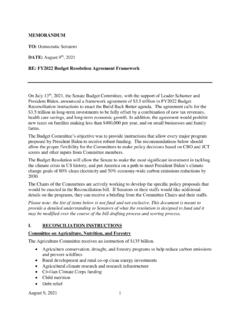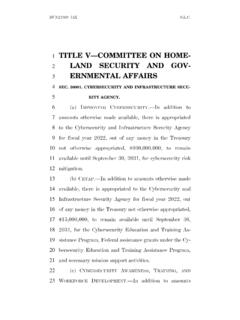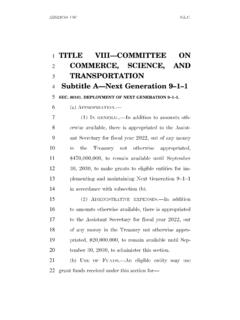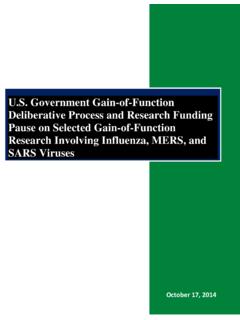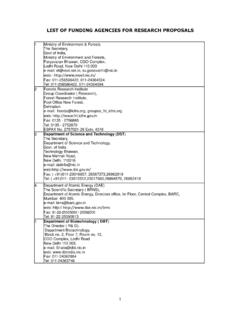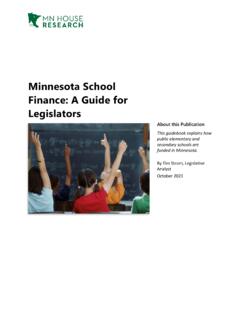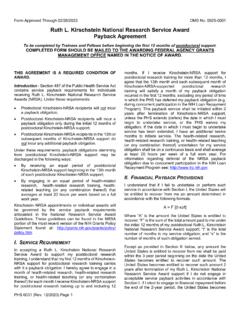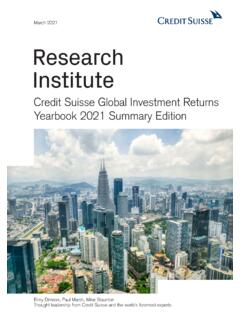Transcription of The United States Innovation and Competition Act of 2021 ...
1 The United States Innovation and Competition Act of 2021 Section-by-section summary Table of Contents Division A - CHIPS Act and ORAN 5G Emergency Appropriations 2 Division B - Endless Frontier Act 4 Division C - Strategic Competition Act of 2021 37 Division D Securing America s Future Act 57 Division E Meeting the China Challenge Act of 2021 76 Division F Other Matters 80 Title I Competitiveness and Security for Education and Medical research 80 Title II Committee on the Judiciary 84 Title III Other Matters 85 2 Division A - CHIPS Act and ORAN 5G Emergency Appropriations Sec. 1001. Table of contents. helpful incentives to produce semiconductors (CHIPS) for America funds.
2 In order to support the rapid implementation of the semiconductor provisions included in the FY21 NDAA, this division provides $52 billion in emergency supplemental appropriations to implement these programs. This includes: $ billion allocated over 5 years for a CHIPS for America Fund. funding must be used to implement the Commerce Department semiconductor incentive and R&D programs authorized by the FY21 NDAA (Sec. 9902 & 9906). Each fiscal year, up to 2 percent of funds are made available for salaries and expenses, administration, and oversight, of which $5 million is available each year for the inspector general. Within the fund, the following appropriations are available: Incentive Program: $39 billion appropriated upfront and allocated over 5 years to implement the programs authorized in Sec.
3 9902. $2 billion is provided to solely focus on legacy chip production to advance economic and national security interests, as these chips are essential to the auto industry, the military, and other critical industries. $19 billion in FY22, including the $2 billion legacy chip production funding $5 billion each year, FY23 through FY26 Commerce R&D programs: $ billion appropriated upfront and allocated over 5 years to implement programs authorized in Sec. 9906, including the National Semiconductor Technology Center (NSTC), National Advanced Packaging Manufacturing Program, and other R&D programs authorized in Sec. 9906. $5 billion in FY22 $2 billion for NSTC $ billion for advanced packaging $500 million for other related R&D programs For use across the NSTC, advanced packaging, and other related R&D programs, the following would be provided: $2 billion in FY23 $ billion in FY24 $ for FY25 and FY26 3 $2 billion for a CHIPS for America Defense Fund: funding is appropriated up front and $400 million is allocated each year, over 5 years for the purposes of implementing programs authorized in Sec.
4 9903(b), providing support for R&D, testing and evaluation, workforce development, and other related activities, in coordination with the private sector, universities, and other Federal agencies to support the needs of the Department of Defense and the intelligence community. $500 million for an O-RAN & CHIPS for America International Technology Security and Innovation Fund: funding is appropriated upfront and $100 million each year, allocated over 5 years to the Department of State, in coordination with the Agency for International Development, the Export-Import Bank, and the International Development Finance Corporation, for the purposes of coordinating with foreign government partners to support international information and communications technology security and semiconductor supply chain activities, including supporting the development and adoption of secure and trusted telecommunications technologies, semiconductors, and other emerging technologies.
5 Each fiscal year, up to $5 million of funds are made available for salaries and expenses, administration, and oversight, of which $500,000 is available each year for the inspector general. for wireless supply chain Innovation . This division includes: $ billion for the Public Wireless Supply Chain Innovation Fund to spur movement towards open-architecture, software-based wireless technologies, funding innovative, leap-ahead technologies in the mobile broadband market. The fund would be managed by the National Telecommunications and Information Administration (NTIA), with input from the NIST, DHS, and IARPA, among others. 4 Division B - Endless Frontier Act Sec. 2001. Short Title; Table of Contents Would state the Act may be cited as the Endless Frontier Act.
6 Sec. 2002. Definitions Would set forth definitions of terms used in the bill. Sec. 2003. Sense of Congress Would add a Sense of Congress on the importance of bipartisan authorization and funding for Innovation , including research at the National Science Foundation ( NSF ) and the Department of Energy (DOE). Sec. 2004. Interagency Working Group Would create an interagency working group, led by the Office of Science and Technology Policy ( OSTP ) and including the NSF, DOE, and DOC, among other agencies to coordinate the activities authorized in the legislation and existing activities. It would also direct the working group to ensure that Federal research efforts are complementary and avoid duplication.
7 Would require, within 180 days, a review of Federal programs in the key technology focus areas and identification of potential overlap and areas for cooperation. Sec, 2005. Key Technology Focus Areas ( FTFAs ) Would task NSF and DOE, in coordination with the interagency working group, with annually reviewing and, if needed, updating the ten key technology focus areas, such as artificial intelligence and quantum science, to guide research and technology development activities. Originally 8Ad(2) in introduced bill TITLE I Definitions. Would set forth definitions of terms used in title I of the bill. Directorate Establishment and Purpose. Would establish a Directorate for Technology and Innovation within NSF to strengthen leadership in critical technologies, accelerate technology commercialization, and engage more students.
8 Would direct basic and applied research , advanced technology development, and commercialization support in the key technology focus areas. Would direct partnership with 5 other directorates of the Foundation, other Federal research agencies, and stakeholders in academia, the private sector, and nonprofit entities. Would require a 10% transfer from the Directorate to the existing offices and directorates of the Foundation, to support basic research in the KTFAs. Originally 8A(b) and (d) of the introduced bill. Personnel Management. Would allow designation of term-limited program directors to establish research and development (R&D) goals, build research collaborations, and monitor progress.
9 Originally 8A(c) of the introduced bill. Innovation Centers. Would authorize $ billion from FY 2022 FY 2026 for university technology centers and Innovation institutes to conduct multi-disciplinary, collaborative research relevant to the key technology focus areas. Would require award selection to account for regional and geographic diversity and the capacity to engage industry, workforce, and other organizations. Originally 8A(d)(6) of the introduced bill. Transition of NSF Programs. Would enable the NSF Director to transfer the management of relevant existing programs to the Directorate, such as convergence accelerators, AI research institutes, and the NSF Innovation Corps.
10 Providing Scholarships, Fellowships, and Other Student Support. Would authorize the Director to fund scholarships, fellowships, traineeships, and postdoctoral awards at $ billion from FY 2022 FY 2026 in support for STEM education and workforce development in the key technology focus areas, with direction to target populations underrepresented in STEM and to improve geographic diversity. Would require that not less than 20% of authorized funds be dedicated to jurisdictions eligible for the NSF EPSCoR program. Originally 8A(e) and 8A(d)(5) of the introduced bill. 6 research and development. Would authorize $ billion from FY 2022 FY 2026 for research and development awards in the key technology focus areas.



